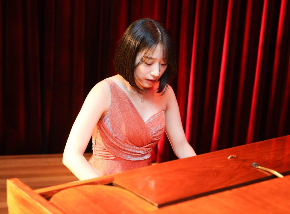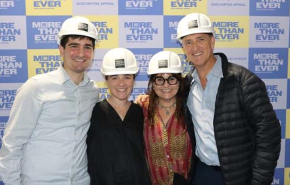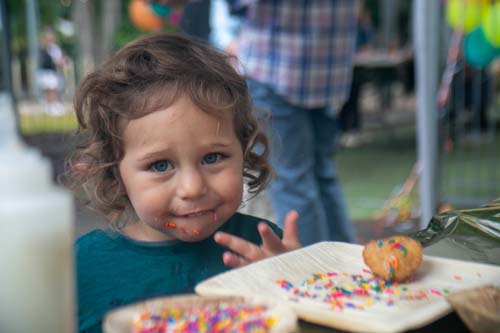From Australia’s Jewish past
Slawa Duldig née Horowitz – inventor, artist, interior designer, and teacher

Slawa Duldig
Slawa was born to Nathan and Antonia on 28 November 1901 in Horocko, Poland. Nathan was then the director of a flour mill in the nearby city of Lvov. In 1911, concerned by increasing political unrest, the Horowitz family relocated from Poland to Vienna where Slawa attended a convent school and showed early promise as a pianist. She and her two siblings all followed creative pursuits. Slawa became an artist and designer, having trained in fine arts at the Viennese School for Women and Girls; her sister Aurelie (‘Rella’) became an actress, and her brother Marek, a lawyer who also wrote poetry and composed music. From 1922 to 1925, Slawa studied with the Viennese sculptor, Anton Hanak, who was associated with the Vienna Secession artistic movement closely related to Art Noveau. In 1929 she graduated from the Akademie der Bildenen Künste Wien (Academy of Fine Arts, Vienna).
In 1928, following a wet-weather visit to the Kunsthistorisches Museum, Vienna, Slawa conceived the idea for a manageable, handbag-sized folding umbrella. She reflected on the event in later life. “It happened [that] one May morning, a cold and rainy day, I armed myself with a big umbrella and muttered to myself, why on earth must I carry this utterly clumsy thing? Can’t they invent a small folding umbrella that could be easily carried in a bag?’’ She sought to remedy the problem of cumbersome umbrellas with much ingenuity and the support of her parents, sister Rella, and close friend Karl Duldig. She drafted designs and obtained umbrella spokes from an industrial source on the pretext that she was designing a lampshade. Next, she engaged a watchmaker to assist with the manufacturing process. Slawa bought some black silk fabric, made a pattern, and attached the silk to a shaft and spokes. Karl suggested the handle be widened to enable the spokes to fit inside. From this, the prototype of a modern folding umbrella emerged. With money loaned by her father, she filed a patent application for the umbrella design with applications being sent to the United Kingdom, Austria, Germany, Italy, France, Poland, and the United States. The patent was issued on 19 September 1929. This amazing invention was kept a secret until Slawa had secured a patent.
The umbrella was commercially branded ‘Flirt.’ The firms of Brüder Wüster in Austria, and Kortenbrach und Rauh in Germany, manufactured the umbrella. Ten thousand ‘Flirt’ umbrellas were sold in the first year of production, with Slawa receiving annual royalties until 1938. ‘Flirt’ featured at the 1931 Vienna Spring Fair, and an enthusiastic journalist with the New World Paper wrote ‘’the sculptress Slawa Horowitz has invented a magic umbrella that can be folded so small it can fit in a handbag”
Slawa married Karl in 1931, their marriage being an artistic union, with the couple having known each other since their days in sculpture class. Their daughter Eva was born in Vienna on 11 February 1938. The family lived in an apartment decorated superbly together, with an architect and head designer from the well-known Viennese firm of Sigmund Jaray.
In 1938, following the occupation of Austria Slawa and Karl knew it was time to leave their home, and the family travelled to Switzerland. Karl went first and once the apartment had been packed, she and Eva followed. She had received notification from the Nazi District Superintendent that she must evacuate the apartment and this official offered to purchase the contents of the apartment. However, he was outwitted by Slawa who advised that the contents had already been sold. She had conspired with a friend, to become the purchaser of the apartment’s contents and told the official in front of her friend. This was a successful move and ensured that Slawa would retain her family’s belongings and she entrusted them to her sister Rella who was living in Paris. Slawa and Eva then travelled to Switzerland on temporary visas organised by Karl and a Swiss immigration official. At the same time, Slawa sold the rights of the ’Flirt’ umbrella to the firm Bruder Wuster. In May 1939, the family arrived in Singapore as refugees. Here, they opened an art school, and Slawa worked in art restoration. With Britain declaring war on Germany, their status as foreign nationals became increasingly problematic and it was in July 1940 that the family became titled enemy aliens and were expelled from Singapore. Together with German and Italian internees they left Singapore by ship and arrived in Sydney on 25 September 1940. They were detained in Tatura Internment Camp in northern Victoria. Karl was released from the camp on 7 April 1942 and immediately joined the 8th Employment
Company unloading cargo from ships in Port Melbourne and transferring goods between trains on the border between Victoria and New South Wales. Slawa and Eva remained in the camp until 14 May 1942. It was not until 7 December that year, that their classification was changed to refuge aliens rather than enemy aliens. The family decided to settle in Melbourne.
Through the International Red Cross, Slawa sought news of her sister Rella who was still living in Paris, and finally on 11 October 1944, she arranged for a shipment of many of the precious Sigmund Jaray signature pieces to be sent to her new home.
In 1945, Slawa attained registration as a teacher of Art and German and was employed by Korowa Church of England Girls Grammar School. In 1947, she was appointed Senior Art and Craft teacher at St Catherine’s Girls School, where she remained for 16 years. Here she was acknowledged for the depth and breadth of her teaching approach, which featured first-hand knowledge of European Old Masters, art, craft, and furniture design, providing innovative opportunities enabling her students to have ‘free expression’ and experimental approaches. Slawa was one of the first teachers in Victoria to offer Art as a Matriculation subject. In 1978 St Catherine’s Girls School inaugurated the senior student Slawa Duldig Art Prize.
In 1945 she and Karl established a hand-made pottery business with Karl producing ceramics, and together they decorated the pieces. Their metropolitan Melbourne retail outlets included The Primrose Pottery Shop, where many prominent artists exhibited their work including Arthur Boyd.
Slawa was not one to sit still. In June 1954, she was one of thirteen women to attend the UNESCO seminar titled, ‘The Role of the Visual Arts in Education’ at Melbourne University Women’s College. She participated in an associated working group on ‘Art in Secondary Schools,’ which forwarded the recommendation that Art should be accorded equal status in the schools with all other subjects.
On 20 June 1968, Slawa and Rella were reunited in Paris. Unfortunately, their brother Marek, their parents, and extended family had ‘…disappeared without any trace’ in wartime Europe.
Slawa passed away in Melbourne on 16 August 1975. It was her wish that Eva set up the Duldig Studio and Sculpture Garden, at the family’s home in Malvern, where several rooms have been maintained as they were during the family’s residence, including the Sigmund Jaray signature pieces. The Museum of Applied Arts and Sciences in Sydney has the prototypes of the ‘Flirt’ on display. Umbrellas of the ‘Flirt’ design continued in production during the twentieth century.
Slawa and Karl’s daughter Eva de Yong-Duldig, became a champion Australian tennis player who played in Wimbledon, the French Championships, the Australian Open, and the Maccabiah Games in Israel where she won two gold medals. A granddaughter Tania de Yong AO is an Australian soprano, social entrepreneur, and businesswoman.
Eva later wrote a memoir, Driftwood: Escape and Survival through Art about her family’s experiences. In 2017, it won a Victorian Community History Award and, in 2018 it was listed for the Nita May Dobbie Literary Award, recognising a first published work from an Australian woman. This memoir was produced as Driftwood – The Musical in 2022 in Melbourne, directed by Wesley Enoch AO with granddaughter Tania having written some of the lyrics. The show received excellent reviews.
The AJHS acknowledges the following references in the preparation of this story:
Wikipedia, Duldig Studios, Austrian Embassy Washington, Theatre Matters, AJN May 22 theatre review

The Australian Jewish Historical Society is the keeper of archives from the arrival of the First Fleet in 1788 right up to today. Whether you are searching for an academic resource, an event, a picture or an article, AJHS can help you find that piece of historical material. The AJHS welcomes your contributions to the archives. If you are a descendent of someone of interest with a story to tell, or you have memorabilia that might be of significance for the archives, please make contact via www.ajhs.com.au or [email protected].









